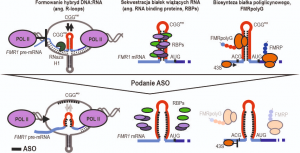Magdalena Derbis, Emre Kul, Daria Niewiadomska, Michał Sekrecki, Agnieszka Piasecka, Katarzyna Taylor, Renate K. Hukema, Oliver Stork & Krzysztof Sobczak: Short antisense oligonucleotides alleviate the pleiotropic toxicity of RNA harboring expanded CGG repeats. Nat Commun 12, 1265 (2021).
Approximately 1 in 5000 men older than 50 suffer from FXTAS (fragile X-associated tremor/ataxia syndrome). Together with FXS (fragile X syndrome) and POI (primary ovarian insufficiency) the FXTAS pathomechanism depends on the expansion of trinucleotide CGG repeats (CGGexp) in the 5′ untranslated region of the FMR1 gene located on chromosome X.
The number of CGGexp in healthy individuals normally estimates around 30. Milder expansions with 55-200 CGG repeats lead to the development of FXTAS and the first symptoms of disease appear between 50 and 60. The main clinical features of FXTAS include intention tremor, gait ataxia, and cognitive decline. For now no curative therapy is currently available.
The molecular basis of FXTAS is still incompletely understood, but three main pathomechanisms of this disorder have been proposed. First, as the 5′UTR region of FMR1 is GC-rich, the cotranscriptional formation of R-loop structures can be induced. Second, mutated FMR1 mRNA can interact with many nuclear RNA-binding proteins (RBPs) and form inclusions in the nucleus of neurons in the brain of patients with FXTAS. Third, repeat-associated non-AUG (RAN) translation of rCGGexp can yield toxic polyglycine-containing proteins (FMRpolyGs) that are prone to form nuclear inclusions in FXTAS patients’ brains.
In the publication of the results obtained by the team of Professor Krzysztof Sobczak from the Gene Therapy Laboratory, part of the Department of Gene Expression at the Faculty of Biology, AMU, in cooperation with the team of Professor Olivier Stork from the Department of Genetics and Molecular Neurobiology at the Otto von Guericke University in Magdeburg, the authors as a therapeutic approach tried to supply of small nucleic acids or their chemical analogs in order to correct the pathological effects of mutated FMR1 gene. As a main task in the work, authors administered short antisense oligonucleotides to the cerebrospinal fluid (CSF) of the FXTAS mouse model. After few months from the beginning of gene therapy, the classical symptoms of FXTAS were no longer observed in treated animals, giving hope to cure neurodegenerative diseases which so far are considered as incurable.


